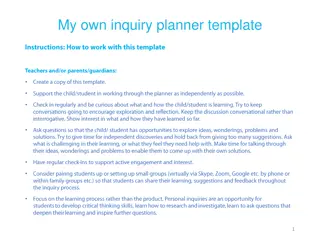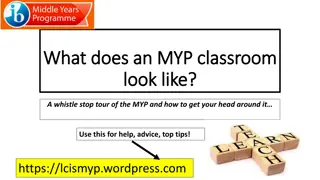Science Inquiry Test and Activities Summary
Join the journey of a student taking a test on the scientific method, exploring experiments at a Science Fair, and deciphering the heliocentric model. Dive into learning objectives, bell work exercises, and engaging activities that enhance understanding of the scientific method. Witness the quest for knowledge unfold through practical applications and thought-provoking questions.
Download Presentation

Please find below an Image/Link to download the presentation.
The content on the website is provided AS IS for your information and personal use only. It may not be sold, licensed, or shared on other websites without obtaining consent from the author.If you encounter any issues during the download, it is possible that the publisher has removed the file from their server.
You are allowed to download the files provided on this website for personal or commercial use, subject to the condition that they are used lawfully. All files are the property of their respective owners.
The content on the website is provided AS IS for your information and personal use only. It may not be sold, licensed, or shared on other websites without obtaining consent from the author.
E N D
Presentation Transcript
Objective Today I will take a test on the scientific method So that I can measure my gains about the steps and methods of science inquiry. know I have it when I have scored a 70 percent or higher.
Wed. September 4thTest Scientific Method C=0 H=none A= Test M=none P= (1) Write your name on your scantron and bubble in 000 then I.D. Number. (2) Set your folders up and wait quietly as I pass out Test. (3) When you are finished raise your hand and I will collect your test. (4) Begin bell work on a separate sheet of paper S= 70 percent or higher
Bell Work September 4th Maria and Lauren are preparing for the Science Fair. They want to learn about how fast a rose bush grows. They choose plants of equal height and each student takes one bush home. They agree to grow their plant inside and to give it 25 milliliters (mL) of water every other day. After one month, the girls compare their results. They find that Maria's plant has grown much taller than Lauren's. The girls are confused by these results. C=0 H=0 M=none What should the girls have done differently to insure their methods were similar? A. chosen a different plant to work with B. used better soil with more organic matter in it C. recorded the heights of the plants every day of the month D. controlled other variables such as how much sunlight the plants got
Bell Work September 5th SC.7.N.3 C=0 H=0 M=none Which statement supports the heliocentric model? A. People now believe the Earth orbits the sun. B. People thought Earth was the center of the universe. C. A telescope showed that some moons orbited Jupiter. D. From Earth, it appears that all objects in the sky move around Earth.
Objective SC.6-8.N.1.4 Today I will discuss and compare the methods used to identify steps in the scientific method. So that I can identify the different parts of the scientific method. I know I have it when I have located at least 70 percent of the elements (parts) of the scientific method.
CHAMPS Scientific Story C=0 H=none A= Identify the scientific method M=none P= Looks like student numbering their own sheet of paper (don t write on handout) Write the number that corresponds with the correct step in the scientific method. Debrief: check over each question as a whole class. Circulate and see which table is correct. S=Check for success.
Analyzing Elements of the Scientific Method Worksheet 1. Which statement(s) contain conclusions? I suggest that the reason sea water freezes at a lower temperature is that sea water contains dissolved salts, while fresh water does not. #10,11 2. Which statement(s) contains a hypothesis? "If sea water has salt in it, it will freeze at a lower temperature than fresh water. #6
3. Which statement(s) contain observations? The scientist notes the taste of sea water and other factors such as waves, wind, air pressure, temperature, and humidity. #5 4. Which statement(s) describe an experiment? a. Fills each of two beakers with 1 liter of fresh water b. Dissolves 35 grams of table salt in one of the beakers c. Places both beakers in a freezer at a temperature of -1 C d. Leaves the beakers in a freezer for 24 hours. # 7
5. In which statement is the problem described? A scientist wants to find out why sea water freezes at a lower temperature than fresh water. #1 6. Which statement(s) contain data? The scientist notes the taste of sea water and other factors such as waves, wind, air pressure, temperature, and humidity. #5 After 24 hours, the scientist examines both beakers and fins the fresh water to be frozen. The salt water is still a liquid. #8
7. Which is the independent (manipulated) variable in the experiment? The effects of salt #7,8 8. What is the dependent (responding) variable in the experiment? After 24 hours, the scientist examines both beakers and finds the fresh water to be frozen. The salt water is still a liquid.#8,9
Measure Soybean Moisture page 3 PH page 5 Temperature page 7 Stem size
Exit Question Juan, a biologist, notices that a particular group of humming birds leaves during the colder winter months and returns during the warmer spring months. Juan hypothesizes that the birds fly south to locations with warmer weather and blooming flowers during the winter months. Which procedure should Juan use to test his hypothesis? A. Survey northern and southern residents about the birds in their areas. B. Observe the direction the birds fly when they depart in the winter. C. Tag the hummingbirds with transmitters and track their movement. D. Set up observation posts in the south to verify the time of year that birds arrive.
C A is incorrect because this procedure does not help Juan verify that he is tracking a single group of birds. B is incorrect because this procedure will not account for changes in the birds paths once they leave the area. Also, it will not help Juan verify the final destination of the birds. C is correct because Juan can track migration through transmitters. D is incorrect because this procedure does not help Juan verify which birds are arriving.
Bell Work September 6th SC.7.N.3 C=0 H=0 M=none Which of the following is a way to gather empirical evidence? A. conduct research on the Internet and in textbooks B. make first-person observations during an experiment C. gather opinions from classmates, teachers, and scientists D. read reports from other experiments that have some of the same variables as your experiments
Objectives SC.8.N.1.5 Today I will match steps in the scientific method with the appropriate detail. I will construct a hypothesis and make predictions So that I can explain the major processes involved in conducting a scientific investigation. (2) distinguish between qualitative and quantitative. (3) Write a hypothesis about critical choices. I know I have it when I have completely answered worksheet question 80 percent and matched the scientific question at 100 percent. Written a hypothesis with if, then and because
Matching Challenge Activity C= 2 with group H= group A= Matching Review M= none P= Looks like student matching the cards as a group then raising their hands when done. When all groups of are done check how well you did. (2) Speed battle, without looking each member will try to match the cards but they are not allowed to look at the projector. S= (Check for success) Winner will receive a ticket
Making prediction in a real world crisis C=0 during the video, then level 2 as a group (don t communicate other groups H= group A= Forming Hypothesis M=limited to helper 3 distributing supplies P= Looks like student 1 listening to group and formulating hypothesis on the white board. When group is finished teacher will circulate and check for understanding. Example: If we choose ______________ then this will happen because ___________________ S= check for success
Lets practice Which plant will grow faster, the one in sunlight or the plant in a closet. If the plant is placed in direct sunlight, then it will grow faster because it is receiving more energy from the light to make food in photosynthesis.
Video Challenge https://www.youtube.com/watch?time_conti nue=9&v=_A9di3JH3pM Start with team member 1 and write your prediction but be careful, your team is depending on you. Let s survey
Scientific Method Identification P.11 Check for understanding C=2 H=group A= Identification of the scientific method M=none P= Looks like students reading the question or problem. Write down the question and either reorder it and solve problem individually, then as a group. Raise your hand when you have the responded as a group to check. Conversation 0 when teacher debriefs and checks for understanding. S=check for success.
Scientific Method Worksheet Put the following steps in order, please number 1 6. _______Hypothesis _______ Draw Conclusion _______ Experiment _______ Ask a Question _______ Analyze data _______ Collect Observations 2 6 3 1 5 4
#2 and #3 Put the following steps of scientific inquiry in order, please number 1 3. 1 _______Make an observation _______ Ask a question _______ Form a hypothesis 2 3 3. Is the following statement a fact, opinion or theory? Why? Opinion, because it is based on one persons belief rather than scientific evidence Scrambled eggs are better for breakfast than cereal. I can stay full longer if I eat eggs.
#4 List if each of the following data is qualitative or quantitative: a. ________________ Green b. ________________ 5.7 grams c. ________________ Large d. ________________ 120 lbs qualitative quantitative qualitative quantitative
Exit Quiz Determine if each statement is true or false about forming a hypothesis: a. It must be long. __________ b. It is an educated guess. _________ c. It is in if then format. __________ d. It must be testable. ___________ e. It must start with I think. ________ F T T T F
Reading a Bar Graph Activity 1. 270 lbs. 2. 310 lbs. 3. Mr. John s class had 200 lbs. -320 lbs. = 120 lbs. more. 4. By 40 s 5. by 20 s 6. Scott s class at 320 lbs. 7. 270 + 310 + 250 + 300 + 200 = 1330 lbs.
Bus Link https://busramp.wixsite.com/shields
7th Period Video after Class https://www.youtube.com/watch?v=BL8Fh_HVr7o
Objectives SC.8.N.1.5 Today I will match steps in the scientific method with the appropriate detail. I will also interpret a graph. So that I can explain the major processes involved in conducting a scientific investigation. (2) distinguish between qualitative and quantitative. (3) Calculate data from making observation from the graph. I know I have it when I have completely answered worksheet question 80 percent and matched the scientific question at 100 percent.
Soil Lab Dry soil Test Moist soil Test Seed measurement and planting
Objectives SC.8.N.1.5 Today I will match steps in the scientific method with the appropriate detail. I will also interpret a graph. So that I can explain the major processes involved in conducting a scientific investigation. (2) distinguish between qualitative and quantitative. (3) Calculate data from making observation from the graph. I know I have it when I have completely answered worksheet question 80 percent and matched the scientific question at 100 percent.























